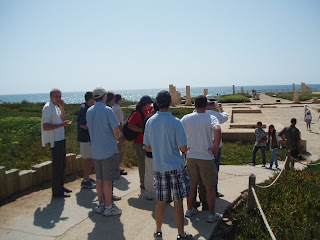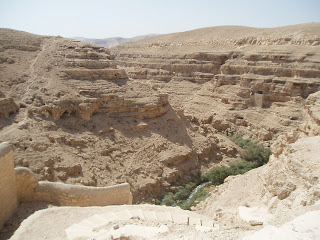In the early morning, we left Bethlehem and we celebrated mass at Shepherd's Field where in Luke 2:8-18 the Angels announced to the Shepherds of Bethlehem the Birth of Christ:
After celebrating mass, we went to the port city of Tel Aviv-Jaffa on the Mediterranean Sea. In ancient times, Jaffa (known then as Joppa). It is mentioned in 2 Chronicles 2:15 as the port of entry from where the cedars of Lebanon were brought to Jerusalem to build King Solomon's Temple and later the Second Temple (Ezra 3:7). It is also citied in Jonah 1:3 as the place where the prophet Jonah embarked for the city of Tarshish. This city was also under Canaanite, Philistine, Phoenician, and Greek Control. It is mentioned also in Greek mythology in relation to the story "Clash of the Titans" in relation to where Perseus rescued Princess Andromeda.
One of the sites that we visited in the city was the Church of Saint Peter which commemorates the place in Acts 9:36-42 where Saint Peter resurrects the widow Tabitha and has a vision of various animals that were clean and unclean and God telling him to take and eat them.
We then went to the ancient port city of Caesaria Maritima, which was built by King Herod the Great between 25-13BC. It was one of the governing seats that the Roman Procurator had to govern Jude a during Roman Times, and there is a fragment that is displayed there that mentions Pontius Pilate and the Emperor Tibereas. This city is also where Saint Peter baptized Cornelius the Centurion, His household and soldiers. It would later become a major center for Christian Evangelization and would be a place where later theologians and historians such as Origen and Eusebius of Caesaria stayed. It would later be taken by the Muslims in 638AD, reclaimed by crusader King Baldwin I, and finally destroyed by the Mamluks in 1265. Today it is a National Park of the State of Israel.
"And in that region there were shepherds out in the field, keeping watch over their flock by night. And an angel of the Lord appeared to them, and the glory of the Lord shone around them, and they were filled with fear. And the angel said to them, "Be not afraid; for behold, I bring you good news of a great joy which will come to all the people; for to you is born this day in the city of David a Savior, who is Christ the Lord. And this will be a sign for you: you will find a babe wrapped in swaddling cloths and lying in a manger." And suddenly there was with the angel a multitude of the heavenly host praising God and saying, "Glory to God in the highest, and on earth peace among men with whom he is pleased!" When the angels went away from them into heaven, the shepherds said to one another, "Let us go over to Bethlehem and see this thing that has happened, which the Lord has made known to us." And they went with haste, and found Mary and Joseph, and the babe lying in a manger. And when they saw it they made known the saying which had been told them concerning this child; and all who heard it wondered at what the shepherds told them."
After celebrating mass, we went to the port city of Tel Aviv-Jaffa on the Mediterranean Sea. In ancient times, Jaffa (known then as Joppa). It is mentioned in 2 Chronicles 2:15 as the port of entry from where the cedars of Lebanon were brought to Jerusalem to build King Solomon's Temple and later the Second Temple (Ezra 3:7). It is also citied in Jonah 1:3 as the place where the prophet Jonah embarked for the city of Tarshish. This city was also under Canaanite, Philistine, Phoenician, and Greek Control. It is mentioned also in Greek mythology in relation to the story "Clash of the Titans" in relation to where Perseus rescued Princess Andromeda.
One of the sites that we visited in the city was the Church of Saint Peter which commemorates the place in Acts 9:36-42 where Saint Peter resurrects the widow Tabitha and has a vision of various animals that were clean and unclean and God telling him to take and eat them.
We then went to the ancient port city of Caesaria Maritima, which was built by King Herod the Great between 25-13BC. It was one of the governing seats that the Roman Procurator had to govern Jude a during Roman Times, and there is a fragment that is displayed there that mentions Pontius Pilate and the Emperor Tibereas. This city is also where Saint Peter baptized Cornelius the Centurion, His household and soldiers. It would later become a major center for Christian Evangelization and would be a place where later theologians and historians such as Origen and Eusebius of Caesaria stayed. It would later be taken by the Muslims in 638AD, reclaimed by crusader King Baldwin I, and finally destroyed by the Mamluks in 1265. Today it is a National Park of the State of Israel.
 |
| Fabritzio explaining the history of the city |
 |
| Some of the Ancient Ruins of the City as well as a replica of the original Roman Amphitheater |
 |
| Statues discovered from Roman times |
 |
| A replica of the original Roman Amphitheater now used for concerts |
 |
| More Roman Ruins |
 |
| The Harbor Line which touches the Mediterranean Sea |
 |
| Ruins of the Circus Maximus where chariot races were held and Christians were fed to the lions |
 |
| A sculpture of Medusa |
 |
| Inside a crusader gate |
 |
| Some of us exploring the Ancient Roman Aqueduct that gave water to the city |
 |
| The Roman Aqueduct |
 |
| Hanging Arches from Crusader Times |
 |
| The Crusader Gate |





















































